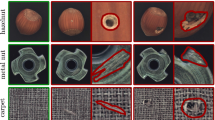Abstract
Film archives are continuously in need of automatic restoration tools to accelerate the correction of film artifacts and to decrease the costs. Blotches are a common type of film degradation and their correction needs a lot of manual interaction in traditional systems due to high false detection rates and the huge amount of data of high resolution images. Blotch detectors need reliable motion estimation to avoid the false detection of uncorrupted regions. In case of erroneous detection, usually an operator has to remove the false alarms manually, which significantly decreases the efficiency of the restoration process. To reduce manual intervention, we developed a two-step false alarm reduction technique including pixel- and object-based methods as post-processing. The proposed pixel-based algorithm compensates motion, decreasing false alarms at low computational cost, while the following object based method further reduces the residual false alarms by machine learning techniques. We introduced a new quality metric for detection methods by measuring the required amount of manual work after the automatic detection. In our novel evaluation technique, the ground truth is collected from digitized archive sequences where defective pixel positions are detected in an interactive process.
Similar content being viewed by others
References
Delaney, B., Hoomans, B.: Prestospace user requirements feedback meeting in London. In: An Integrated Solution for Audio-Visual Preservation and Access (2004)
Czúni L., Hanis A., Kovács L., Kránicz B., Licsár A., Szirányi T., Kas I., Kovács Gy. and Manno S. (2004). Digital motion picture restoration system for film archives (DIMORF). SMPTE Motion Imaging J. 113: 170–176
Kokaram A.C. (2004). On missing data treatment for degraded video and film archives: a survey and a new Bayesian approach. IEEE Trans. Image Process. 13(3): 397–415
Ghaderi, M., Kasaei, S.: Novel post-processing methods used in detection of blotches in image sequences. AEÜ Int. J. Electron. Commun. (58), 58–64 (2004)
Kokaram A.C., Morris R., Fitzgerald W. and Rayner P. (1995). Detection of missing data in image sequences. IEEE Trans. Image Process. 4(11): 1496–1508
Gangal, A., Kayikçioglu, T., Dizdaroglu, B.: An improved motion-compensated restoration method for damage color motion picture film. Signal Proc. Image Commun. (19), 353–368 (2004)
Nadenau, M.J., Mitra, S.K.: Blotch and scratch detection in image sequences based on rank ordered differences. In: Time-Varying Image Processing and Moving Object Recognition, pp. 27–35. Elsevier, Amsterdam (1997)
Tilie, S., Laborelli, L.: Blotch detection for digital archives restoration based on the fusion of spatial and temporal detectors. In: The 9th International Conference on Information Fusion, Florence, Italy, pp. 1–8 (2006)
Ren, J., Vlachos, T.: Segmentation-assisted dirt detection for the restoration of archived films. Proceedings of BMVC, vol. 1, Oxford, England, pp. 359–368 (2005)
Licsár, A., Czúni, L., Szirányi, T.: Trainable post-processing method to reduce false alarms in the detection of small blotches of archive films. IEEE International Conference on Image Processing (ICIP), Italy, pp. 562–565 (2005)
Naranjo, V., Albiol, A., Mossi, J.M., Albiol, A.: Morphological Lambda Reconstruction Applied to Restoration of Blotches in Old Films. Proceedings of the 4th IASTED International Conference on Visualisation, Imaging and Image Processing, Spain (2004)
Tenze, L., Ramponi, G., Carrato, S.: Robust detection and correction of blotches in old films using spatio-temporal information. Proceedings of SPIE International Symp. Electronic, San Jose, pp. 348–357 (2002)
Joyeux L., Boukir S., Besserer B. and Buisson O. (2001). Reconstruction of degraded image sequences. Application to film restoration. Image and Vision Computing (MAVIS) 19(8): 503–516
Tenze, L., Ramponi, G., Carrato, S.: Blotches Correction and Contrast Enhancement for Old Film Pictures. Proceedings of the International Conference on Image Processing, ICIP, Canada, pp. 660–663 (2000)
Kokaram A.C. (1998). Motion Picture Restoration: Digital Algorithms for Artefact Suppression in Degraded Motion Picture Film and Video. Springer, Heidelberg
Lagendijk, R.L., van Roosmalen, P.M.B., Biemond, J.: Video enhancement and restoration. Handbook of Image& Video Processing, Academic Press, San Diego, pp. 227–242 (2000)
Hamid M.S., Harvey N.R. and Marshall S. (2003). Genetic algorithm optimization of multidimensional grayscale soft morphological filters with applications in film archive restoration. IEEE Trans. Circuits Syst. Video Technol. 13(5): 406–416
Buisson, O., Boukir, S., Besserer, B.: Motion Compensated Film Restoration. Machine Vision and Applications, Vol 13, Issue 4, pp. 201–212 Springer, Heidelberg (2003)
Schallauer P., Pinz A. and Haas W. (1999). Automatic restoration algorithms for 35 mm film. Videre J. Comput. Vis. Res. 1(3): 60–85
Licsár, A., Czúni, L., Szirányi, T.: Adaptive Stabilization of Vibration on Archive Films. Lecture Notes in C.S, LNCS 2756 pp. 230–237. Springer, Heidelberg (2003)
Bergen J.R., Burt P.J., Hingorani R. and Peleg S. (1992). A three-frame algorithm for estimating two-component image motion. IEEE Trans. Pattern Anal. Mach. Intell. 14(9): 886–896
Burt P.J. and Adelson E.H. (1983). The Laplacian pyramid as a compact image code. IEEE Trans. Commun. 31(4): 532–540
Fukushima K. (1975). Cognitron: a self-organizing multilayered neural network. Biol. Cybern. 20: 121–136
Cortes C. and Vapnik V. (1995). Support-vector network. Mach. Learn. 20: 273–297
Rumelhart, D., Hinton, G., Williams, R.: Learning internal representations by error propagation. Parallel Distributed Processing, MIT Press, Cambridge, pp. 318–362 (1986)
Czúni, L., Császár, G., Hanis, A., Kovács, L., Licsár, A., Szirányi, T.: Semi automatic digital motion picture restoration system with learning capabilities. In: Learning for Adaptable Visual Systems (LAVS), Cambridge, UK, 2004
Cybenko G. (1989). Approximation by Superposition of a Sigmoidal Function. Math. Control Signals Syst. 2: 303–314
Author information
Authors and Affiliations
Corresponding author
Rights and permissions
About this article
Cite this article
Licsár, A., Szirányi, T. & Czúni, L. Trainable blotch detection on high resolution archive films minimizing the human interaction. Machine Vision and Applications 21, 767–777 (2010). https://doi.org/10.1007/s00138-007-0106-y
Received:
Accepted:
Published:
Issue Date:
DOI: https://doi.org/10.1007/s00138-007-0106-y




